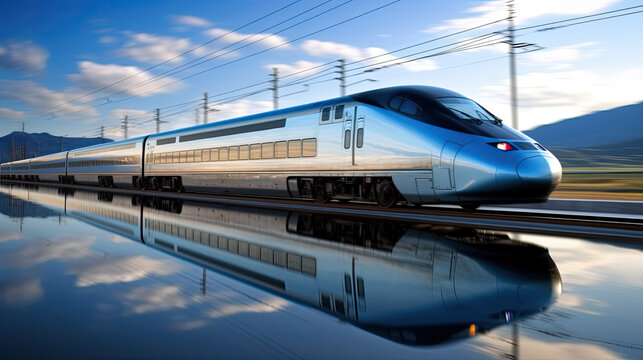We are a society fascinated by speed. From fast cars to super-fast computing devices, humans are trying to contract time and space in this zealous need for speed. In this landscape, where every minute counts, introducing high-speed rail (HSR) corridors emerges as a beacon of progress.
Indian Railways is the fourth largest railway network in the world. It carries 8,400 million passengers and over 1,500 million tonnes of freight annually. Furthermore, the track network spans a distance of about 70,000 km. As India strides towards development and aims to become a global superpower, transforming the 167-year-old railway system is crucial.
Bullet Trains: Ushering in a New Age of Speed
High-speed Rails (HSR), known as Bullet Trains, has become a symbol of global futuristic travel (mainly for distances between 500-800 km). Introducing HSR in India will act as a catalyst for economic growth, environmental sustainability, and overall development. The new rail services will connect India’s economically vital mega-regions. It will make them more productive, mobile, and internationally competitive.
HSR offers accessible, safe, and efficient travel, reducing congestion on roads and other modes of transport. Additionally, it promotes tourism and stimulates demand for construction materials, benefiting industries like cement and steel. Environmentally, the bullet train project is lauded for its low carbon emissions. This aligns with global efforts to reduce transportation-related carbon emissions.
Also Read: 5 Major Infra Projects to be inaugurated before 2024 elections
Bullet Train Project: A Timeline of Progress

Technological Marvels of HSR
The introduction of bullet trains heralds a new era in India’s transportation infrastructure, with the deployment of cutting-edge technologies such as LiDAR and Static Refraction Topography. These technologies help facilitate precise route mapping and construction planning. Additionally, passengers will benefit from innovative features like aerodynamically designed trains, and improved bogie technologies for noise reduction.
The state-of-the-art bullet trains will zip at speeds of 320 km/h. With trains running at such high speeds and handling heavy traffic volumes, the best global technology in HSR – Japanese Shinkansen technology – has been selected.
Strategic Expansion
The National Rail Plan (NRP) for India envisions enhancing the outreach of the bullet train system and increasing connectivity to all important cities. The Ministry of Railways has entrusted NHSRCL (National High-Speed Rail Corporation Ltd) with the task of preparing the Detailed Project Reports (DPRs). As part of the National Infrastructure Project (NIP), NHSRCL has identified seven HSR corridors. These include:
- Mumbai – Ahmedabad (508 km)
- Delhi – Lucknow – Varanasi (813 km)
- Delhi – Jaipur – Udaipur – Ahmedabad (872 km)
- Nagpur – Nasik – Mumbai (767 km)
- Varanasi – Patna – Howrah (752 km)
- Delhi – Chandigarh – Ludhiana – Jalandhar – Amritsar (476 km)
- Mumbai – Pune – Hyderabad (671 km)

Also Read: Top Upcoming Highway Projects by MSRDC
Mumbai-Ahmedabad Bullet Train (MAHSR Corridor)
The MAHSR corridor is India’s first high-speed railway line, heavily influenced by Japanese standards and expertise. Spearheaded by NHSRCL, the MAHSR project spans 508 kilometres. Starting from Mumbai’s Bandra Kurla Complex (BKC), the high-speed train will stop at 10 cities, before terminating in Sabarmati. The entire journey will be completed in 2.07 hours (with limited stops), compared to the current 6-9 hours.
The total estimated project cost is INR 108,000 Crore and is progressing in 9 packages. The authorities have awarded all civil contracts and completed 100% land acquisition. It will comprise 12 aesthetically designed stations, eight maintenance depots, and three rolling stock depots. Moreover, it features an HSR training institute in Vadodara and a High-Speed Rail Multi-Modal Hub in Sabarmati.
As of May 2024, the foundation work at Thane and Palghar is in progress.

Mumbai-Nagpur High-Speed Rail (MNHSR) Corridor
The proposed 741 km Rail line will connect Mumbai with Nagpur through Nasik, Shirdi, and Aurangabad. The expected stations of the proposed MNHSR Bullet Train are Shahapur, Igatpuri, Nasik, Shirdi, Aurangabad, Jalna, Mehkar, Malegaon Jahangir, Karanja Lad, Pulgaon, Wardha, and Nagpur.
At the Mumbai end of the line, the new MNHSR Bullet Train will start from Thane or nearby. It will further branch off the 508.17 km Mumbai Ahmedabad High-Speed Rail corridor. As of May 2024, the project is in various phases of surveying.
Mumbai-Hyderabad Bullet Train
This planned bullet train line will connect India’s economically vital hubs – Mumbai and Hyderabad. The high-speed rail line runs 767 km across 11 stations in Maharashtra and Telangana. Set to be the third bullet train project involving Mumbai, this line will reduce the travel time between the two cities from the current 15 hours to 3.5 hours.
The planned stations of the line are BKC in Mumbai, Navi Mumbai (at Navi Mumbai International Airport), Lonavala, Pune, Kurkumb/Daund, Akluj, Pandharpur, Solapur, Kalaburagi (Gulbarga), Zaheerabad, and Hyderabad.
As of May 2024, NHSRCL has presented the DPR to the Ministry of Railways for approval.
Delhi-Ahmedabad High-Speed Rail (DAHSR) Corridor
The 886 km high-speed rail corridor will connect Delhi, Jaipur, Udaipur, and Ahmedabad through 12 stations. This is one of the seven new high-speed rail corridors planned by the Government of India in 2019. The line will have its southern terminal at Sabarmati Station in Ahmedabad which is currently under construction. The DAHSR Corridor, once completed, will integrate with the MAHSR Bullet train and operate as one unified line.
In September 2020, NHSRCL invited bids for preparing the DAHSR corridor’s final alignment design (using LiDAR surveys). Currently, various survey works are in progress for the proposed corridor.
Delhi-Varanasi High Speed Rail (DVHSR) Corridor
It is India’s second bullet train project after the Mumbai-Ahmedabad High-Speed Rail Corridor. This high-speed rail line will connect two prominent cities of India, Delhi and Uttar Pradesh (Varanasi). The 865-km HSR corridor will incorporate 12 stations. These are – Delhi, Noida, Jewar Airport, Mathura, Agra, New Etawah, South Kannauj, Lucknow, Raebareli, Prayagraj, New Bhadohi, and Varanasi.
This line is part of the Diamond Quadrilateral Project and will be extended to Patna, Bihar and Kolkata. The proposed DVHSR Corridor will run along major expressways, national highways, and greenfield areas. Furthermore, it may pass through arterial roads of the inter-city road network along the corridor.
As of May 2024, NHSRCL has completed the DPR for the Delhi-Varanasi High-Speed Rail.
Also Read: Top 10 Upcoming Mega Projects in India
Varanasi – Howrah (Kolkata) High-Speed Rail (VHHSR Bullet Train) project
The project will connect three vital cities in Eastern India, Varanasi, Gaya and Kolkata. The 760 km-long rail line will comprise several stations. The VHHSR Bullet Train would complete the journey between the cities in just over two hours at a speed of 350 km/h.
The proposed stations on the Varanasi-Howrah High-Speed Rail Corridor are Varanasi, Buxar, Arrah, Patna, Nawada, Dhanbad, Asansol, Durgapur, Burdaman, and Howrah. As of May 2024, various survey works for the VHHSR Bullet Train Project are underway.
Delhi-Amritsar Bullet Train Project
Being a part of one of India’s planned seven bullet train lines, this line connects the country’s capital Delhi with Punjab’s Amritsar. The high-speed route will cut the distance between the two cities from the existing six hours to under two.
The Delhi-Amritsar Bullet Train would start from Dwarka in Delhi and halt in Amritsar. The 465 km high-speed rail line will run through Asaudha, Rohtak, Jind, Kaithal, Sangrur, Malerkotla, Ludhiana, and Jalandhar. It will follow a greenfield route through central Haryana and the Delhi – Amritsar – Katra Expressway’s alignment.
As of May 2024, NHSRCL has completed the socio-economic survey for the Delhi – Amritsar High-Speed Rail (DAMHSR) Corridor. Moreover, the Ministry of Railways has started the land survey.
Also Read: Top 10 Railway Redevelopment Projects in India 2024
Reference:

Biltrax Construction Data is tracking 30,000+ projects on their technology platform for their clients.
Get exclusive access to upcoming projects in India with actionable insights. Gain a further competitive advantage for your products in the Indian Construction Market.
Visit www.biltrax.com or email us at contact@biltrax.com to become a subscriber and generate leads.
Disclaimer: The information herein is based upon information obtained in good faith from sources believed to be reliable. All such information and opinions can be subject to change. Furthermore, the image featured in this article is for representation purposes only. It does not in any way represent the project. If you wish to remove or edit the article, please email editor@biltrax.com.
Discover more from Biltrax Media, A Biltrax Group venture
Subscribe to get the latest posts sent to your email.






















